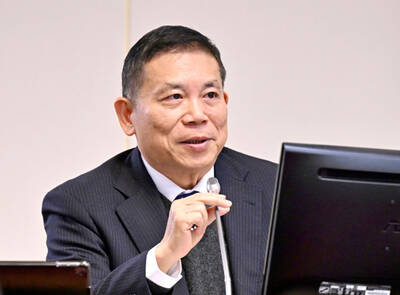DRAM chipmaker Nanya Technology Corp (南亞科技) yesterday reported its smallest losses in three quarters as recovering demand helped drive higher average selling prices and factory utilization.
Losses improved significantly to NT$1.21 billion (US$37.79 million) during the quarter ending on March 31, compared with losses of NT$2.48 billion in the previous quarter and losses of NT$1.69 billion a year earlier, the company said in a statement.
Gross margin improved to minus-2.9 percent, the best in five quarters, thanks to a high-single-digit percentage increase in average selling prices and lower idle equipment costs, Nanya Technology president Lee Pei-ing (李培瑛) told a virtual media briefing.

Photo: Grace Hung, Taipei Times
As its average selling price is expected to increase by a double-digit percentage this quarter, Lee said it is highly possible that gross margin would swing back into positive territory this quarter, an indicator that Nanya Technology is continuing to progress toward a turnaround.
“There is a chance that the average selling price will improve quarter by quarter,” he said. “We are more optimistic about DRAM price improvements” due to the effects of a massive earthquake that struck off the east coast on Wednesday last week.
Samsung Electronics Co, SK Hynix Inc and Micron Technologies Inc have resumed price negotiations with customers following a brief suspension awaiting damage assessments after the quake, which measured 7.2 on the Richter scale and magnitude 7.4 on the moment magnitude scale.
The top three companies have become more aggressive about pricing during the latest round of negotiations with customers, which could boost DRAM prices, Lee said.
Nanya Technology said the global DRAM industry would stage a gradual recovery this year, adding that the supply of DRAM chips could tighten after a bulk of the world’s DRAM capacity is used to produce high-density or high-bandwidth memory chips for artificial intelligence (AI) servers rather than standard servers.
On the demand side, the arrival of AI PCs later this year would increase the consumption of DRAM chips, coupled with increases in sales of premium smartphones in China, the company said.
However, it remains to be seen when the company will reverse six straight quarters of operating losses, given damage from the earthquake and volatile foreign exchange rates, it said.
The company’s production has been fully restored after a brief suspension due to the quake, it said.
In the first quarter, operating losses improved to NT$2.92 billion, compared with losses of NT$4.05 billion in the previous quarter and losses of NT$2.89 billion a year earlier, the company said.
Nanya Technology yesterday raised its capital spending this year 30 percent to NT$26 billion from an earlier estimate of NT$20 billion.
Shipments are expected to increase more than 20 percent annually this year, it said.

Taiwan will prioritize the development of silicon photonics by taking advantage of its strength in the semiconductor industry to build another shield to protect the local economy, National Development Council (NDC) Minister Paul Liu (劉鏡清) said yesterday. Speaking at a meeting of the legislature’s Economics Committee, Liu said Taiwan already has the artificial intelligence (AI) industry as a shield, after the semiconductor industry, to safeguard the country, and is looking at new unique fields to build more economic shields. While Taiwan will further strengthen its existing shields, over the longer term, the country is determined to focus on such potential segments as

UNCERTAINTY: Innolux activated a stringent supply chain management mechanism, as it did during the COVID-19 pandemic, to ensure optimal inventory levels for customers Flat-panel display makers AUO Corp (友達) and Innolux Corp (群創) yesterday said that about 12 to 20 percent of their display business is at risk of potential US tariffs and that they would relocate production or shipment destinations to mitigate the levies’ effects. US tariffs would have a direct impact of US$200 million on AUO’s revenue, company chairman Paul Peng (彭雙浪) told reporters on the sidelines of the Touch Taiwan trade show in Taipei yesterday. That would make up about 12 percent of the company’s overall revenue. To cope with the tariff uncertainty, AUO plans to allocate its production to manufacturing facilities in

COLLABORATION: Given Taiwan’s key position in global supply chains, the US firm is discussing strategies with local partners and clients to deal with global uncertainties Advanced Micro Devices Inc (AMD) yesterday said it is meeting with local ecosystem partners, including Taiwan Semiconductor Manufacturing Co (TSMC, 台積電), to discuss strategies, including long-term manufacturing, to navigate uncertainties such as US tariffs, as Taiwan occupies an important position in global supply chains. AMD chief executive officer Lisa Su (蘇姿丰) told reporters that Taiwan is an important part of the chip designer’s ecosystem and she is discussing with partners and customers in Taiwan to forge strong collaborations on different areas during this critical period. AMD has just become the first artificial-intelligence (AI) server chip customer of TSMC to utilize its advanced

Chizuko Kimura has become the first female sushi chef in the world to win a Michelin star, fulfilling a promise she made to her dying husband to continue his legacy. The 54-year-old Japanese chef regained the Michelin star her late husband, Shunei Kimura, won three years ago for their Sushi Shunei restaurant in Paris. For Shunei Kimura, the star was a dream come true. However, the joy was short-lived. He died from cancer just three months later in June 2022. He was 65. The following year, the restaurant in the heart of Montmartre lost its star rating. Chizuko Kimura insisted that the new star is still down